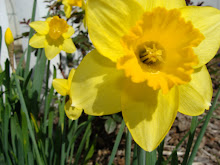 In response to a few requests for specific garden plans, I put together some ideas for a raised bed. Finally I had a few minutes to totally think out my plan and get some notes written. I'll list below my plant suggestions, locations, and purposes. I hope you like this! A couple of notes before we get started...
In response to a few requests for specific garden plans, I put together some ideas for a raised bed. Finally I had a few minutes to totally think out my plan and get some notes written. I'll list below my plant suggestions, locations, and purposes. I hope you like this! A couple of notes before we get started...1. This plan assumes the planter receives full sun.
2. I live in Southern California, but ask your local garden center for specifics on when to plant if you are far away or in a much different climate.
3. This particular color scheme is in the white/blue/purple range (as opposed to red/yellow/orange).
4. Last, this is going to be what I call a "baby" garden. It won't have big immediate impact because you'll buy all little 4" pots or seeds, which are far less expensive. But by mid-summer and next Spring, your plants will be all grown up.
I love to plant herbs and edibles, and this year I am particularly focused on getting the herb garden really packed with edible flowers so that I can have a flower party in mid-summer. Here is a list of great plants, followed by a planting chart.
Spanish Lavender. Perhaps in the future we can discuss more specifics about the varieties, but to keep it easy, I would just head off to Home Depot or Armstrong and pick up a 4" pot of whatever looks nice and smells good to you.
Rosemary. Cut it and toss it in with your roasted meats, chop it up for use in breads, and sometime this summer I'll write out a recipe for delicious rosemary vanilla ice cream. Rosemary has lovely little flowers that can also be used for your culinary delight. Rosemary will grow into a very big bush, so be sure to harvest regularly to keep the shape the way you like!
Thyme is grows in a lovely mound and can be used in the kitchen for just about anything. This is one of my favorite little plants to add to herbal flower arrangements.
Common Sage has a light purple to blue flower and grows perennially for me.
Purple Sage has green foliage with a purple tinge, which adds a nice interest to the greens.
Carnations, Bachelor buttons, chives, nasturtiums, and pansies. These plants I would buy as seeds or in six-packs, keeping in mind the blue/purple/white color theme. All of their flowers are edible and would look lovely in a salad…just look at the cover of Sunset Magazine!
So the goal here is to use the perennial lavender and rosemary as the background, and Thyme and Sage in the foreground. The back row will have alternating lavender and rosemary with carnations in between. The front row will have alternating thyme, purple sage, and common sage with nasturtium seeds, pansies, chives, and bachelor buttons in between.
I am currently re-planting some things in the vegetable garden so that I can have a nice little herb border like this. Did I miss things you like planting in this color range? Let me know - I'd love suggestions!

 I had a conversation with a friend yesterday who shared with me about how she is using her newly found gardening skills as a way to talk about Jesus with her daughter. What a natural time to share the parable of the sower and the seed! As they worked the soil together, she told her daughter the story as found in Matthew chapter 13:
I had a conversation with a friend yesterday who shared with me about how she is using her newly found gardening skills as a way to talk about Jesus with her daughter. What a natural time to share the parable of the sower and the seed! As they worked the soil together, she told her daughter the story as found in Matthew chapter 13: 





 The yellow rose is a
The yellow rose is a  As I was poking around, I found a ladybug making a meal of another bug, so I thought I'd share that, too. We put out two praying mantis casings, too, so I should have some praying mantis photos
As I was poking around, I found a ladybug making a meal of another bug, so I thought I'd share that, too. We put out two praying mantis casings, too, so I should have some praying mantis photos 




































